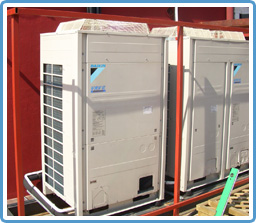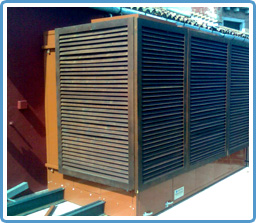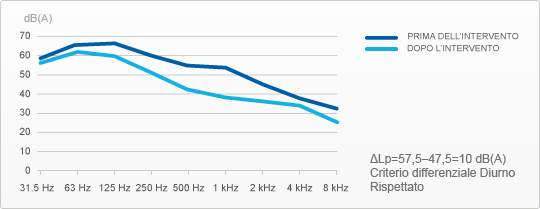INTRODUCTION
The Law of October 26th, 1995 No. 447 "Framework Law regarding Noise Pollution"
establishes the fundamental principles concerning the protection of the outdoor environment
and residential from noise pollution.
The D.P.C.M. November 14, 1997, in implementation of the Law "447", defines the values
absolute daytime and nighttime limit of output and input of noise in the external environment and the differential criterion within the living environments.
Absolute Emission Limit Values dB(A)
The emission limit value is the maximum noise value that can be
emitted from a sound source, measured, in spaces usable by people or communities, in
proximity of the source itself (usually the measurement is done at the limit of the property of the
disturbing and practically must be at least 5 dB(A) lower than the zone limit for
allow others to "produce noise").


CASE HISTORY
CLASS III - mixed-type areas: urban areas affected by local vehicular traffic
or crossing, with a medium population density, with presence of commercial activities,
offices with limited presence of craft activities and absence of industrial activities; areas
rural areas affected by activities involving operating machines
Noisy emissions sources consisting of 2 groups
Daikin air cooled water chillers (inverter model VRVIII)
operating during the daytime, intermittently, depending on the
requests from the plant.
The groups were placed on the terrace on the 3rd floor of the ENPALS building, Calle Emo, 1553 / A in Venice.
The surrounding area is predominantly residential, with some commercial or hotel activity.
The buildings are almost all of the height of 3-4 floors, which overlook a narrow court closed
on 3 and a half sides of four, and particularly reverberating.
Noisy emissions sources have been the subject of an acoustic cleanup
carried out through a sound-insulating sound-absorbing wall on 3 sides and
a sound-absorbing panel on the rear wall and, in expulsion on the fans placed above the group,
a soundproofing box.
 |
 |
|
| York Group after acoustic intervention | York Group before acoustic intervention |
The results
After the intervention the problem was solved, the decrease was in fact of
10 dB(A) and the diurnal differential criterion was respected (environmental noise level
inside residential environments less than 50 dB(A)).

The following topics were discussed during the seminar held throughout Italy
"Architectural and industrial acoustics: solutions and application systems for buildings
of the tertiary sector and for industrial buildings, noise barriers and enclosures ".
Contact us to request advice or further information